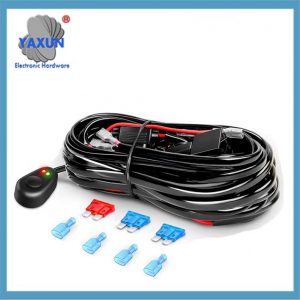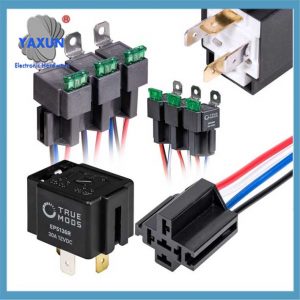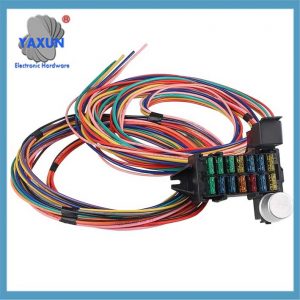The fuse box harness mainly involves fuse holders, fuse boxes and related harness components. Functions and structures of fuse holders and fuse boxes. Fuse holders are used to install fuses and provide overload protection. The fuse box is a place to centrally manage multiple fuses.
 16AWG Automotive Blade Fuse 12V LED Pod Light Wiring Harness Kit 2 Leads With On-Off Rocker Switch Relay |
 6 5 Pin Fuse Relay Switch Wiring Harness Set SPDT 14AWG 30A 12V Hot Fuse Wire US |
 14 Circuit Wiring Harness Kit, Professional Universal Electrical Wire Harness, Car Modification |
Fuse box harness analysis and selection guide
I. Core structure and function
Fuse box and harness components
Fuse box: Made of high-temperature resistant plastic or metal material, it integrates multiple fuse slots to centrally manage fuses in different circuits to ensure that a single circuit failure does not affect the overall system67.
Harness assembly: Contains power cord, signal cord and ground cord. Some high-end models integrate relay modules to support multi-circuit control (such as 12-way and 20-way). Key components
Fuse holder: The fuse is fixed with conductive materials (such as zinc alloy) and has a built-in fuse protection mechanism. It will fuse to cut off the current when overloaded.
Protective design: Zum Beispiel, Jiangsu Chezhilian’s patented wiring harness fixing frame (CN 222727944 U) prevents cables from bending or contacting heat sources through adjustable angles and limit support rods.
2. Selection and adaptability
Parameter matching
Current capacity: It needs to be selected according to the load current characteristics. Circuits containing impact current need to additionally check the fuse life (such as 12V modified wiring harness adapted to 1A-100A fuse).
Number of loops: Common specifications include 12, 15, Und 20. New energy models require a higher number of loops (such as 36-way fuse box harness).
Scenario adaptation
Conventional models: Universal fuse box harness (such as Volkswagen V80 instrument harness) needs to match the original vehicle interface (such as ACC power supply F19, F20).
Modification requirements: High-power equipment (such as audio, inverter) needs to be equipped with high-current fuses (such as MAXI type 20A-100A) and multi-circuit harnesses.
3. Installation and maintenance specifications Installation process Power-off operation: Disconnect the vehicle power supply before installation to avoid electric shock or damage to components.
Line connection:
The power cord is connected to the normal power (such as the roof light fuse F1/F22) and the ACC power supply (such as the cigarette lighter F19).
The signal line is matched by color (such as the vehicle speed signal connected to the ABS module pin 10 or the ECU pin 19). Test verification: Use a multimeter to detect the continuity, and test the function (such as the instrument panel display) after restoring the power. Wiring requirements The wiring harness fixing spacing must be reasonable, the threading sheath is used at the through hole, and the sharp parts are protected by rubber. The fuse box harness is separated and fixed from the oil circuit to avoid interference or safety hazards.
IV. Market and technology trends
Mainstream products
Universal type: Alibaba platform supplies 12-way and 15-way fuse box harnesses, with prices ranging from 0.18 Zu 225 yuan/piece, and supports customization (such as special harnesses for new energy vehicles).
Intelligent upgrade: Semiconductor chips replace traditional fuses (such as smart fuse boxes), reducing volume by 15% and weight by 20%.
Technology development
Integration: The domain controller architecture gradually replaces distributed harnesses to reduce the number of cables (such as L3 autonomous driving models).
Modularity: The adjustable fixing frame patent (CN 222727944 U) supports flexible adaptation to the interior space and reduces maintenance costs.
V. Purchase suggestions
Priority matching model: When purchasing, clarify the original car year and central control model (such as Volkswagen V80 requires a special harness).
Verify compliance: Ensure that the product has passed UL and RoHS certification and meets the flame retardant performance standards.
The above content integrates technical documents, patents and market product parameters, covering the structure, selection, installation and technical evolution direction of the fuse box harness.
Fuse harness
DeepSeek-R1 full blood version Answer completed
Deep thinking completed It took 24 seconds to search 22 materials on the entire network
Automotive fuse harness analysis and technical points
1. Core functions and protection mechanisms
Circuit safety protection The fuse is connected in series to the upstream of the circuit, and the fuse cuts off the current when overloaded or short-circuited through the fusing characteristics to prevent the wire from overheating and catching fire. Fast-acting fuses (BF) are suitable for short-term pulse currents (such as lights and resistor loads), and slow-acting fuses (SBF) are used for high-current scenarios (such as motor loads). System independence Each circuit is equipped with an independent fuse to ensure that a single-circuit fault does not affect the operation of the vehicle’s electrical system.
2. Structural design and innovative technology
Waterproof fuse socket
Great Wall Motors patent (CN 222705960 U): It adopts a combination design of base, fuse plug and cover, and the clamping part cooperates with the inner wall of the cover to improve the sealing and solve the problem of functional failure in a humid environment1.
Application scenarios: engine compartment, chassis and other areas susceptible to water vapor erosion.
High temperature resistant wheel harness assembly
Changchun Volkswagen patent (CN 222705197 U):
The sheathed wire uses an aluminum foil layer to isolate the external heat, with a temperature range of -40℃~200℃ and supports 600V voltage.
The dynamic area is fixed by injection molding, and the static area is fixed by cable ties/pins to expand the wiring space.
3. Parameter selection and matching specifications
Fuse capacity calculation
Rated current: Determined according to the load characteristics (including impact current) and ambient temperature, and the fuse life needs to be verified.
Wire diameter matching: Ensure that the wire smoke time is later than the fuse blowing time, and the short-circuit current needs to trigger the fuse quickly.
Specification classification
Fast-blow type (1A-30A) and slow-blow type (20A-100A) are selected according to the load type, and color identification assists in quick identification.
IV. Installation and maintenance requirements Wrapping process
The engine compartment wiring harness is wrapped with a threaded tube or corrugated tube, taking into account wear resistance and flame retardancy; the instrument wiring harness can be fully wrapped or flower wrapped with tape.
The branch part needs to be fixed with cross-wrapped tape to prevent the wiring harness from twisting or stripping at the end.
Troubleshooting
Frequent fuses need to check whether the load power is over the limit, and replace the original fuse with the same color code first.
V. Technology development trend Highly integrated protection: Such as the modular clip-on design of Great Wall’s patent, which simplifies the maintenance process and improves the sealing1.
Resistant to extreme environments: Aluminum foil layer + double-layer sheath structure (Changchun Volkswagen patent) supports the high voltage and high current requirements of new energy vehicles.
Mainstream product configuration examples
Waterproof fuse socket, snap-on seal design: IP67 protection level for engine compartment/chassis wiring harness
Note: The above content integrates patent innovation, selection standards and installation specifications, covering the functional design, technology upgrade and engineering practice of fuse wiring harness.
Before discussing how to design a fuse box, let’s first talk about the matching of wires and fuses. This will also help us better understand the fuse box problem later.
First, we need to determine the capacity of the fuse based on the current characteristics of the load and the working environment of the fuse, and then calculate the required wire diameter based on the load characteristics and the environment of the wiring harness. For circuits protected by fuses, it is necessary to confirm the matching between the wiring harness and the fuse before determining the wire diameter.
The calculation of fuse capacity is actually the calculation of rated operating current. Jedoch, if the load contains inrush current, the inrush current needs to be calculated. After the capacity is initially determined, the life of the fuse is checked for the inrush current until its capacity is finally determined.
Rough selection can be divided into:
A. Fuse capacity > working current of electrical appliance or motor stall current (generally < 70% of fuse capacity)
B. Wire capacity > fuse capacityelectrical appliance (generally <85% of capacity at wire grade temperature)
C. Switching capacity > fuse capacityelectrical appliances (generally <85% of switching capacity)
d. Relay capacity > fuse capacity electrical appliances (generally < 85% of relay capacity)
e. Connector terminal > fuse capacityelectrical appliance (generally <85% of terminal capacity)
The calculation of wire diameter starts with the calculation of the rated current, which needs to consider the load characteristics, the ambient temperature of the wire harness, and the number of power loops in the same branch wire harness. For circuits protected by fuses, a matching calculation is required to ensure that the time it takes for the conductor to start smoking is greater than the time it takes for the fuse to blow. Finally, check the short-circuit current to ensure that the short-circuit current is enough to cause the fuse to blow in time when a fault occurs.
Fuse selection:
In electrical circuits, the main function of fuses is to protect wires. If there is a current flowing through it, it will reach its fusing temperature within a period of time and interrupt the circuit.
The time it takes for a fuse to blow is related to its own temperature rise, which depends on the ratio of rated current/rated power (I/IF): the larger this value, the faster the fuse will blow.
The characteristics of a fuse are composed of two curves, and there are relevant standards (DIN, ISO, JASO)
Let’s give an example to illustrate how this curve is represented:
For 30A current, this fuse will blow in 0.15s to 5s.
For 90A current, this fuse will blow in 0.02s to 0.10s.
According to the speed of fusing time, they can be divided into fast-blow fuses and slow-blow fuses.
Choice of wire type:
The wire type used in wire harness design focuses on the environment and function of the wire harness. Zum Beispiel: the ambient temperature around the engine is high, and there are a lot of corrosive gases and liquids. daher, be sure to use high-temperature-resistant, ölresistent, vibration-resistant, and friction-resistant wires. The wires on the trunk lid must maintain their elasticity at low temperatures, so cold elastic wires must be used to ensure their normal operation. The wires on the automatic transmission must be resistant to high temperatures and hydraulic oil, and their temperature stability must be good. Weak signal sensors should use shielded wires, such as knock sensors, crankshaft position sensors, ABS wheel speed sensors, usw. The door inner wire has high bending resistance requirements.
The ambient temperature of the car plays a vital role in the selection of wires. Each area on the vehicle has its own ambient temperature, typically 85°C for the cabin area and 105°C for the engine compartment. But each car manufacturer has its own ambient temperature standards.
The wires commonly used in automobile wiring harnesses usually use multi-stranded copper wires, and the insulation is PVC insulation material. The wires used in wiring harnesses must be temperature-resistant, ölresistent, Tragenresistent, wasserdicht, anti-corrosion, anti-oxidation, and flame-retardant.
Commonly used wire types in automotive wiring harnesses include Japanese standards (AVSS, usw.), national standards (QVR), German standards (FLRY), American standards and other series. AVSS (AVS) wires are characterized by thin insulation and good flexibility. QVR is characterized by thick insulation, relatively soft and good ductility. German standard wire insulation is thinner and more flexible. American standard wire insulation is generally made of thermoplastic or thermosetting elastomer, and some are processed by irradiation technology. Appropriate types of wires can be selected according to user needs and different working environments.
Calculation of wire diameter
After determining the capacity of the fuse, you can calculate and select the wire diameter. First determine the material of the wire according to the ambient temperature of the wiring harness and then calculate the required wire diameter. Generally divided into two situations: no fuse protection and fuse protection. Circuits without fuse protection are generally non-power supply circuits such as signal connections. When designing, it is necessary to consider the rated operating current, the voltage drop due to line impedance, and the temperature rise of the pulse current.
For lines protected by fuses, in addition to the above calculations, it is also necessary to check the matching of the wiring harness and the fuse and check the short-circuit current. The algorithm is as follows.
The general approach is to make the fusing characteristic curve of the fuse based on the wire smoke characteristic curve. If the abscissa is current and the ordinate is time, the heating characteristic curve of the wire should be above the fusing characteristic curve of the fuse without crossing. That is, the heating time of the wire under any heating current must be greater than the fusing time of the fuse.
In fact, for ordinary vehicle low-voltage fuses and wiring harnesses, to meet the above conditions, you only need to ensure that the maximum current of the wire without smoke is greater than the minimum melting current of the fuse.
The minimum melting current of a fuse is generally calculated as 135% of the rated current of the fuse.
For the verification of short-circuit current, calculate the impedance of the wire according to the length of the wire, plus the impedance of the node, which is the total impedance of the loop, and then calculate the short-circuit current from this. To ensure that the fuse can be completely disconnected in the event of a short circuit, the general short-circuit current value should be greater than 350% of the fuse’s rated current. If the value is lower than this value, test verification or re-selection of wires is required.
 English
English العربية
العربية Български
Български Čeština
Čeština Dansk
Dansk Nederlands
Nederlands Suomi
Suomi Français
Français Deutsch
Deutsch Magyar
Magyar Italiano
Italiano 日本語
日本語 한국어
한국어 Português
Português Română
Română Русский
Русский Slovenščina
Slovenščina Español
Español Svenska
Svenska Tiếng Việt
Tiếng Việt
